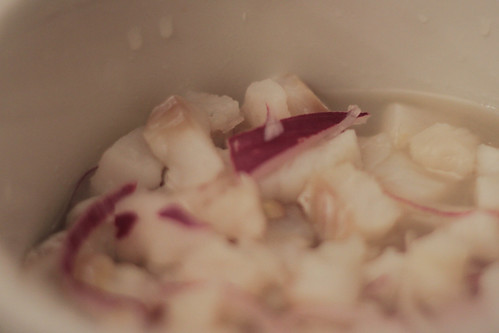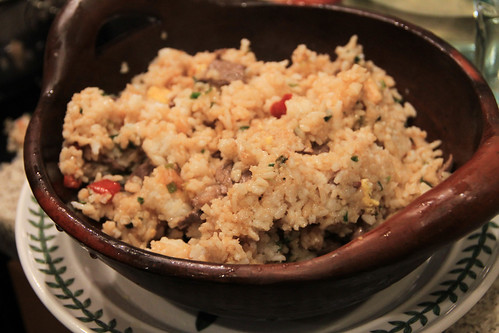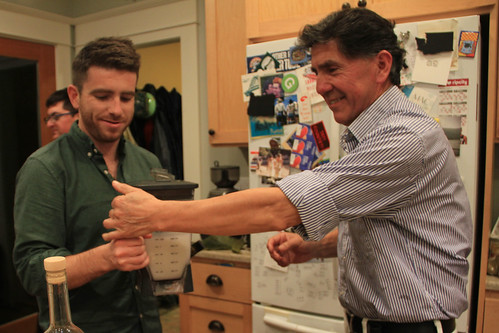From coastline to towering mountains to jungle, Peru offers a ton of geographic diversity. From Inca to Spanish to Asian, it’s also become a converging point of several populations, which of course has influenced the food too. It took a bit of doing, but fortunately our guest Dan helped me a whole lot in pulling together a menu that represented as much variety as possible in a semi-coherent meal. And speaking of helpful guests, muchísimas gracias to my aunt Marcia, who hand-squeezed well over 100 key limes for the ceviche and the pisco sours.

Our enthusiastic guests for the evening were Dan, Lucy, Quinn, Marcia, Jeff, Eleanor, Amilcar, Jan, Lauren, Chris, Ted and friends.
Cebiche | Lime-cooked fish | Recipe

No surprise that this dish represents the coastal region!
I’m a big believer in the theory that often, the freshest fish is in the freezer — it’s usually frozen right at sea, so it’s spent but a few hours at most out of the water. Using frozen fish also gives me more flexibility in my shopping schedule, I can buy it in advance and just gently defrost when needed. So I present to you a ceviche (or cebiche, in Spanish it’s essentially pronounced somewhere between a B and a V as we know them in English anyway) made with some Trader Joe’s cod. And it was good — not a truly memorable ceviche, but tasty and a good way to start the meal. It helped to have cancha, the giant Peruvian (hence, original) version of corn nuts which I was surprised to also find at TJ’s, as well as some green plantain chips and lettuce cups.
Papas a la huancaína | Potatoes with spicy cheese sauce | Recipe
Potatoes are natively from the Andes Mountains, so of course that’s the food to represent that part of the country.
Out of the many things Peruvians do with potatoes, this dish struck me as oddly specific, but I kept seeing it in my research and it seems this really is one of, if not the most, popular uses of the spud. The potato itself is simply peeled and boiled, but the sauce is something I’d never conceived of: fresh cheese, evaporated milk, a specific type of medium-hot yellow chili…and crackers, all thrown together in the blender with the aim of a thick but pourable consistency.
Frankly put, this sauce wasn’t exactly my favorite: it kinda felt like heavy, slightly grainy, moderately spicy, and intense mayonnaise, or perhaps like a bizarro aïoli. But in Peru, it’s apparently such a hit that they put the sauce on all sorts of other things, perhaps like we treat ranch dressing. Huh.
Arroz chaufa | Fried rice | Recipe

For well over a century, there’s been a substantial Asian presence in Peru. Chinese and Japanese alike were brought over to provide agricultural labor, and of course they brought their foodways with them. Peruvian-Chinese cuisine and the restaurants that serve them have their own name, chifa, which is derived from the Cantonese words meaning “eat rice.” Similarly, chaufa means “fried rice,” so the name literally means “fried rice rice.” (The other best-known chifa dish is lomo saltado, which is strips of beef stir-fried with soy sauce and vegetables and served over…french fries!)
Among the options offered in the recipe, I chose to make this with beef and the thin egg omelette. Frankly, it tasted kinda like the fried rice I’d expect to find at an American Chinese restaurant, I’m not exactly clear on what makes this dish particularly Peruvian-influenced. (The bell peppers, perhaps?) Though I will say, the MSG — which I bought for the very first time in my life for this meal — definitely made it even better!
Juanes | Steamed rice tamales | Recipe

The western extent of the Amazon basin, on the eastern side of the Andes, actually represents the majority of the country’s land mass, but those forbidding mountains plus the challenge of getting around the jungle keeps the outside attention largely focused elsewhere. The dish I found at the intersection of distinctive, relatively common, and something I could prepare with ingredients I can find here is, well, what I made.
Juanes are associated with the Feast of St. John on June 24, and Wikipedia has a fascinating claim: “The dish could have a pre-Columbian origin, but it is known that after the arrival of the Spanish people to Incan lands, missionaries popularized the biblical account of the beheading of St. John. This dish’s name could therefore be, more specifically, a reference to the head of St. John.”
What’s in St. John’s Head? Well, it’s a close cousin of tamales, similar to the Central American version in that it’s a moist dough wrapped in green leaves. However, the typical post-Columbian filling is now rice rather than corn, and the leaves aren’t banana but rather from a plant called bijao. (I figured I wouldn’t find them and went to grab banana leaves at the Hispanic market, but I noticed a different kind of bundle of leaves with a name that wasn’t bijao — which thankfully the Internet helped me conclude was in the same genus, Heliconia, and therefore was surely more appropriate than banana leaves.) The rice is drenched in lard — I went through two cups of the stuff to make the dish for sixteen people — and the filling a tasty blend of hen meat and other tasty bits like onions, olives, and yucca shavings (because apparently the rice isn’t enough starch.)
I spent a pleasant portion of the morning listening to the radio and rolling them up, and then throughout the afternoon they gently steamed. Even though there was plenty of other food on offer, most people managed to eat some if not all of these big ol’ lumps, which is a testament to how tasty and satisfying they were.
Pisco sour | Recipe

We won’t get into the debate over whether the pisco sour belongs to Chile or Peru. We enjoyed it for that meal (albeit minus egg whites and plus bubbly), and we really enjoyed it for this one. While the ingredients and technique are straightforward, it clearly took an expert’s touch to perfect, as Amilcar demonstrated. Our only regret was that we had just one bottle of pisco, so we each enjoyed our one glass of frothy, tangy goodness with concentration and relish.
Alfajores | Filled cookies | Recipe

We just made alfajores for Paraguay. So why again for Peru? Because for both countries it really is the proper dessert, and because a guest brought the cookies last time and I wanted to try my own hand. And whaddya know, there is actually a bit of a difference: while both are rolled-out buttery cookies made with both cornstarch and flour, the other ones were a bit puffier whereas the Peruvian ones are less leavened and therefore flatter, and also crumblier both in the hands and on the tongue. I happen to like these better. Big thanks to Dan and Lucy for carefully assembling these fragile treats — though, in the great tradition of pastry prep, I wouldn’t blame them if they happened to hide any mistakes by eating them!